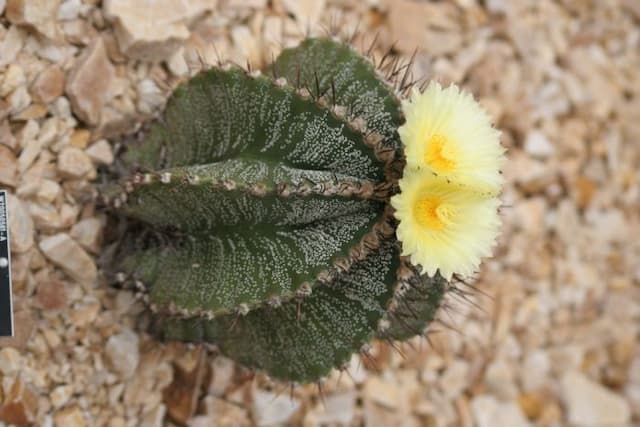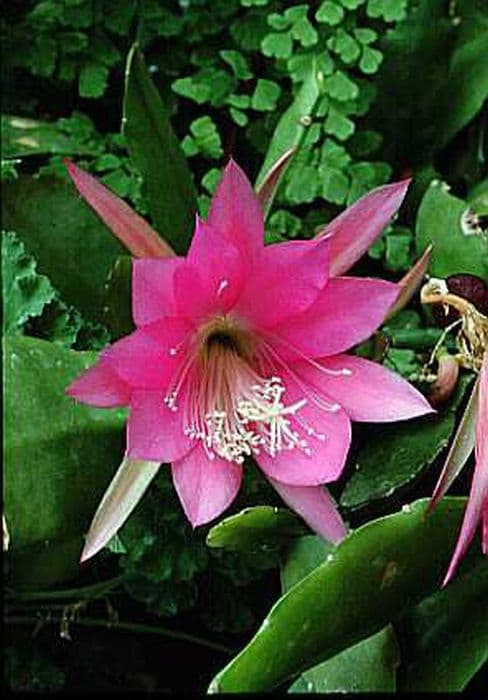Mammillaria geminispina

ABOUT
The plant is characterized by a globular or somewhat elongated shape that branches out minimally. Its surface is densely covered with white spines that lend it a somewhat furry appearance. These spines are actually modified structures which, in the wild, help protect the plant from the harsh sun and prevent water loss. It typically exhibits a green to blue-green color, providing a striking contrast against the white spines. The plant has radially arranged tubercles, which are small, rounded, and bulbous extensions that cover the surface. At the tip of each tubercle, there is an areole from which spines emerge. This feature gives the plant a textured look that is quite appealing. These areoles are a key characteristic, functioning as the spine-producing site. The blooms of this plant are noteworthy as well. When flowering, it produces small, funnel-shaped flowers that range in color from pink to red, adding a pop of color that stands out against its spiny background. These flowers form a halo around the top of the plant, providing a crown of color during the blooming season. Overall, the plant presents as a spiny, spherical to elongated globular succulent with contrasting colors and textures that make it a popular choice for collectors and gardeners looking for interesting and drought-tolerant plants. Its appearance encompasses the lush verdancy typical of succulents, paired with protective and ornamental spines, and punctuated beautifully with its vibrant flowers when in season. It’s a plant that strikes a balance between ruggedness and beauty, well-suited to a variety of settings as a distinctive living ornament.
About this plant
 Names
NamesFamily
Cactaceae
Synonyms
Twin-Spined Cactus, Biznaga de Chilitos
Common names
Neomammillaria geminispina, Chilita geminispina, Ebnerella geminispina
 Toxicity
ToxicityTo humans
Twin-spinning cactus, or Mammillaria geminispina, is not known to be toxic to humans. However, it is important to exercise caution as the spines can cause physical injury if handled improperly.
To pets
Twin-spinning cactus is generally not considered toxic to pets. As with humans, the primary concern is the physical harm that can be caused by the sharp spines, which could lead to injuries if a pet attempts to chew or swallow the plant.
 Characteristics
CharacteristicsLife cycle
Perennials
Foliage type
Evergreen
Color of leaves
Green
Flower color
Pink
Height
6 inches (15 cm)
Spread
4 inches (10 cm)
Plant type
Cactus
Hardiness zones
9
Native area
Mexico
Benefits
 General Benefits
General Benefits- Decorative Appeal: Mammillaria geminispina, commonly known as the Twin-spined cactus, is a visually appealing plant that adds a unique texture and shape to home and garden settings.
- Low Maintenance: As a succulent, this cactus requires minimal watering and maintenance, which makes it an ideal plant for people with busy lifestyles or those new to gardening.
- Drought Tolerant: It is highly drought-resistant, making it perfect for xeriscaping and for gardeners in arid climates who want to conserve water.
- Propagation Ease: Twin-spined cactus can be easily propagated from offsets, allowing plant enthusiasts to easily expand their collection or share with others.
- Compact Size: Its small size makes it suitable for growing in containers, on windowsills, or in limited space areas.
- Longevity: Cacti are known to be long-lived plants, which means Mammillaria geminispina can be a lasting part of your collection with proper care.
- Stress Reduction: Like many plants, caring for cacti such as the Twin-spined cactus can offer therapeutic benefits and help reduce stress levels.
- Enhances Learning: Maintaining and observing plant growth can have educational benefits, especially in understanding botany and plant life cycles.
 Medical Properties
Medical PropertiesThis plant is not used for medical purposes.
 Air-purifying Qualities
Air-purifying QualitiesThis plant is not specifically known for air purifying qualities.
 Other Uses
Other Uses- As a natural pest deterrent: The sharp spines of the Twin-spine cactus can be used in the garden to help deter small animals and insects from nibbling on other plants.
- Photography subject: Due to its distinct appearance, the Twin-spine cactus is often used as a subject in botanical photography and art, capturing the symmetry and texture of its spines.
- Education and study: The plant is used in educational settings, such as schools and botanical gardens, to teach about desert plant adaptations and cacti morphology.
- Habitat for insects: In its natural environment, the Twin-spine cactus provides shelter and microhabitat for small desert insects, playing a role in the local ecosystem.
- Crafts and ornaments: The dried cactus or its parts can be used in making craftwork or decorative pieces, sometimes used in dioramas or as natural ornaments during particular festivities.
- Landscaping rock gardens: Twin-spine cactus is used in xeriscaping and drought-resistant landscapes, adding unique texture and form to rock gardens.
- Stress relief: Some people grow Twin-spine cactus as a form of horticultural therapy, which can offer relaxation and stress relief through the care of plants.
- Feng Shui element: It is sometimes used as a Feng Shui element to add the 'wood' aspect to spaces, supposedly bringing balance and positive energy.
- Soil erosion control: In larger outdoor plantings, this cactus's root system can help to control soil erosion in some arid environments.
- Collector's item: The Twin-spine cactus might be sought after by succulent and cacti enthusiasts as a collector’s item, prized for its unique twin-spined appearance.
Interesting Facts
 Feng Shui
Feng ShuiThe Twin-Spine Cactus is not used in Feng Shui practice.
 Zodiac Sign Compitability
Zodiac Sign CompitabilityThe Twin-Spine Cactus is not used in astrology practice.
 Plant Symbolism
Plant Symbolism- Resilience: Mammillaria geminispina, commonly known as the Twin-Spined Cactus, is a symbol of resilience due to its ability to thrive in harsh, arid conditions where other plants might fail to survive.
- Protection: The sharp spines of the Twin-Spined Cactus serve as a natural defense mechanism, symbolizing the need for establishing boundaries and protecting oneself from external harms.
- Adaptability: As a plant that can adapt to limited resources and still flourish, the Twin-Spined Cactus represents the ability to adjust to challenging situations and environments, making the best out of what is available.
- Beauty and Harshness Combined: With its delicate flowers that blossom from a spiky exterior, the Twin-Spined Cactus signifies the coexistence of beauty and harshness, reminding us that there is often grace to be found within difficult circumstances.
- Independence: Due to its low maintenance nature, the Twin-Spined Cactus is often associated with independence and self-sufficiency, emphasizing the importance of relying on oneself.
 Water
WaterThe common name for Mammillaria geminispina is Twin-spine Cactus. Water the Twin-spine Cactus thoroughly but infrequently, making sure the soil is completely dry between waterings. During the active growing season, in spring and summer, you might water every 7-10 days; use about one-quarter to a half gallon per watering, depending on the size of the pot. Reduce watering to once a month or less during winter dormancy. Always avoid waterlogging as this can lead to root rot.
 Light
LightThe Twin-spine Cactus thrives best in bright, indirect light. It can also tolerate direct sunlight but should be acclimated slowly to prevent sunburn. The ideal spot for this plant is a south or east-facing window where it can get plenty of light without the harsh midday sun.
 Temperature
TemperatureThe Twin-spine Cactus prefers temperatures between 70°F and 80°F during active growth. It can withstand temperatures as low as 50°F and as high as 90°F but should not be subjected to frost. The ideal conditions for this cactus are a warm environment with good airflow.
 Pruning
PruningPruning is not commonly necessary for the Twin-spine Cactus. However, if you need to remove damaged or diseased spines, do so with care and precision using tweezers or small gardening shears. The best time for any necessary pruning is during the plant's active growing season in the spring and summer.
 Cleaning
CleaningAs needed
 Soil
SoilThe Twin-spined Cactus (Mammillaria geminispina) thrives in a porous cactus potting mix with good drainage. A mixture of 50% potting soil, 25% perlite, and 25% fine gravel or sand works well. This cactus prefers slightly acidic to neutral pH levels, ideally from 6.0 to 7.5.
 Repotting
RepottingTwin-spined Cactus should be repotted every two to three years or when the plant has outgrown its current pot. Use fresh, well-draining cactus soil mix during spring or summer for best results.
 Humidity & Misting
Humidity & MistingTwin-spined Cactus prefers low humidity levels typical of arid environments. Ensure the surrounding humidity remains moderate to low, not exceeding 50% to mimic its natural dry habitat.
 Suitable locations
Suitable locationsIndoor
Place in bright, indirect sunlight and ensure good air circulation.
Outdoor
Full sun to partial shade; protect from extreme weather.
Hardiness zone
9-11 USDA
 Life cycle
Life cycleMammillaria geminispina, commonly known as the Twin-spined Cactus, begins its life cycle as a small seed, which when sown in well-draining soil and with adequate warmth, will germinate. Upon sprouting, the young seedlings start to develop their characteristic spines and tubercles, requiring bright light but careful watering to avoid rot. As they mature, these cacti grow slowly and may produce offsets, which can be separated to form new plants. The Twin-spined Cactus typically blooms in late spring to early summer, bearing funnel-shaped, pink or white flowers, usually around the crown of the plant. Following pollination, these cacti may produce small, elongated fruits containing seeds that can be collected for propagation. Over years, with proper care, Mammillaria geminispina may reach a size of 10-20 cm in height, continuing to flower annually with the right seasonal cues.
 Propogation
PropogationPropogation time
Spring-Early Summer
The most popular method for propagating the Twin-spined Cactus (Mammillaria geminispina) is through offsets, which are small clones that naturally grow from the base of the parent plant. To propagate by offsets, carefully separate the offset from the mother plant using a sharp knife, ensuring that you get some roots if they are present. Allow the offset to callous for a few days to prevent infection; a dry, shaded location is ideal for this process. Once the cut surface has healed, you can plant the offset in a cactus potting mix, placing it in bright but indirect light and moderately watering (approximately 1/4 cup or 59 milliliters, which is about 60 milliliters in the metric system) to maintain slight moisture without causing rot. With time and proper care, the offset will establish its own roots and grow to become an independent plant. This method is often done in the spring or early summer when the plant is actively growing.









